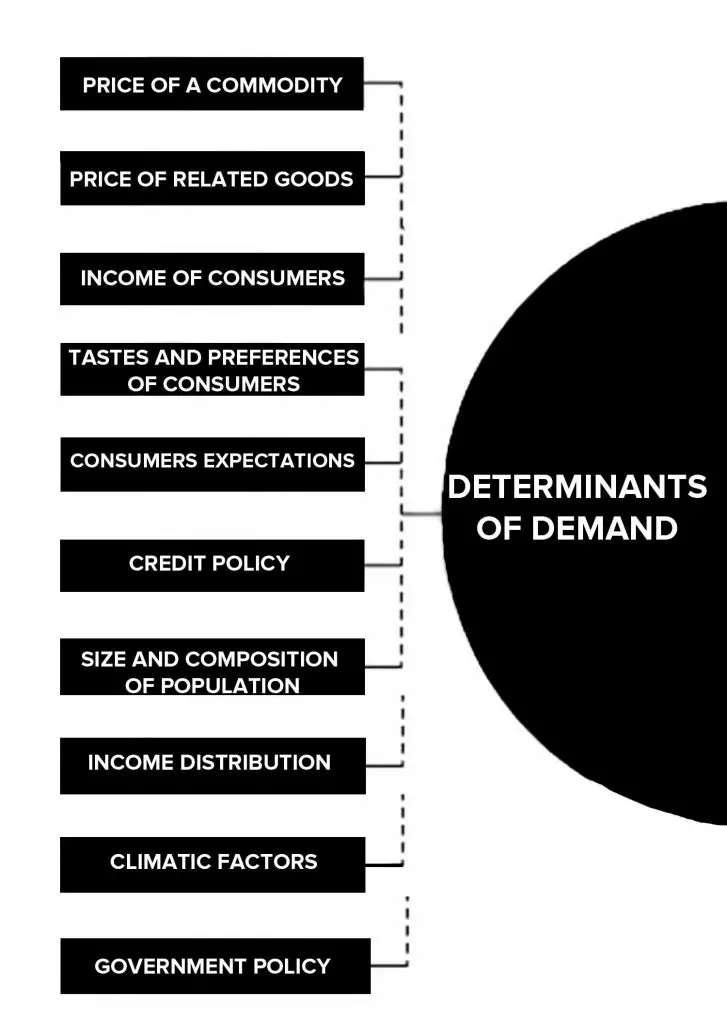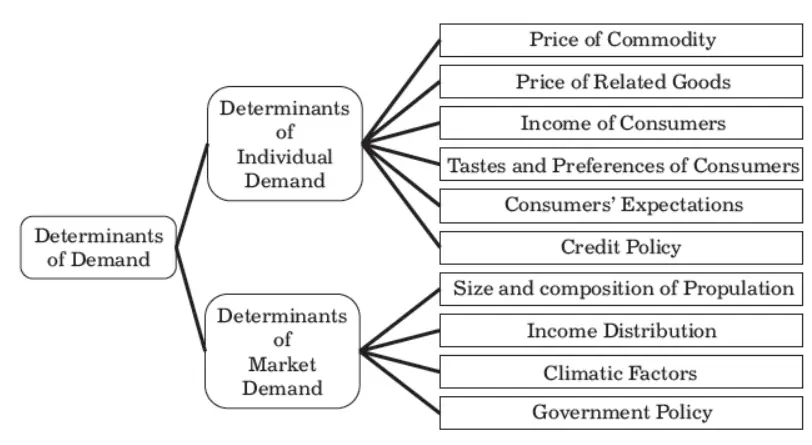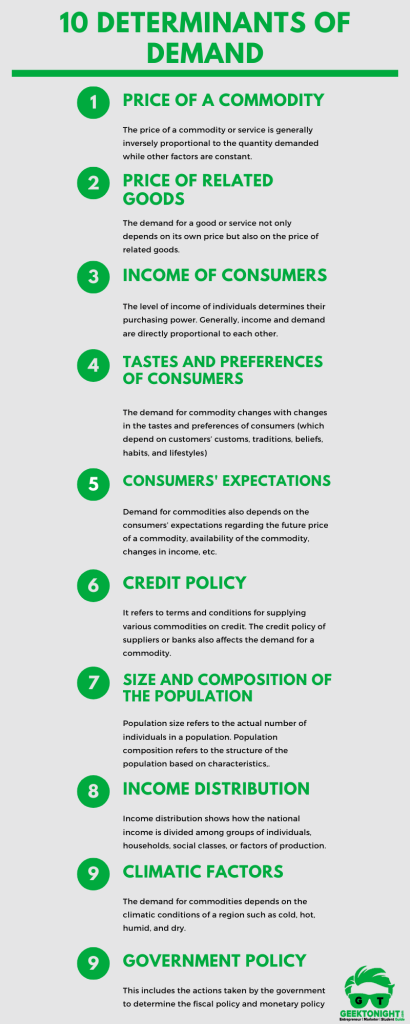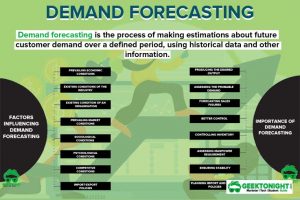What are Determinants of Demand?
Determinants of demand are the factors that influence the decision of consumers to purchase a product or service.
It is essential for organisations to understand the relationship between the demand and its each determinant to analyse and estimate the individual and market demand for a commodity or service.
The quantity demanded for a commodity or service is influenced by various factors, such as price, consumers’ income and preferences, and growth of population.
For example, the demand for apparel changes with changes in fashion and tastes and preferences of consumers.
This can be expressed as follows:
DA = f (PA, PO,………I, T)
where,
PA = Demand for commodity A
f = Function
PO = Price of other related products
I= Income of consumers
T= Tastes and preferences of consumers

Table of Content
What is Demand in Economics?
Demand is an economic principle can be defined as the quantity of a product that a consumer desires to purchase goods and services at a specific price and time.
Also Read: What is Business Economics?
Determinants of Demand
What are the factors affecting demand? In economics, there are 10 determinants of demand for individual and market.
- Price of a commodity
- Price of related goods
- Income of consumers
- Tastes and preferences of consumers
- Consumers expectations
- Credit policy
- Size and composition of the population
- Income distribution
- Climatic factors
- Government policy

- Determinants of Individual Demand
- Price of Commodity
- Price of Related Goods
- Income of Consumers
- Tastes and Preferences of Consumers
- Consumers Expectations
- Credit Policy
- Determinants of Market Demand
- Size and composition of Population
- Income Distribution
- Climatic Factors
- Government Policy

Factors Influencing Individual Demand
When an individual intends to purchase a particular product, he/she may take into consideration various factors, such as the price of the product, the price of substitutes, level of income, tastes and preferences, and the features of the product.
These considerations determine the individual demand of the product. Let us now discuss the factors that influence individual demand as follows:
Price of a commodity
The price of a commodity or service is generally inversely proportional to the quantity demanded while other factors are constant. As per the law of demand, it implies that when the price of the commodity or service rises, its demand falls and vice versa.
The demand for a good or service not only depends on its own price but also on the price of related goods. Two items are said to be related to each other if the change in price of one item affects the demand for the other item. Related goods can be categorised as follow
- Substitute or competitive goods: These goods can be used interchangeably as they serve the same purpose; thus, are the competitors of each other.
For example, tea and coffee, cold drink and juice, etc. The demand for a good or service is directly proportional to the price of its substitute. - Complementary goods: Complementary goods are used jointly; for example, car and petrol.
There is an inverse relationship between the demand and price of complementary goods. This implies that an increase in the price of one good will result in fall in the demand of the other good.
For example, an increase in the price of mobile phones not only would lead to fall in the quantity demanded but also lower the demand for mobile cover or scratch guards.
Income of consumers
The level of income of individuals determines their purchasing power. Generally, income and demand are directly proportional to each other. This implies that rise in the consumers’ income results in rise in the demand for a commodity.
However, the relationship depends on the type of commodities, which are listed below:
Let us discuss different types of commodities in detail.
- Normal goods: These are goods whose demand rises with an increase in the level of income of consumers.
For example, the demand for clothes, furniture, cars, mobiles, etc. rises with an increase in individuals’ income. - Inferior goods: These are goods whose demand falls with an increase in consumers’ income.
For example, the demand for cheaper grains, such as maize and barley, falls when individuals’ income increases as they prefer to purchase higher quality grains. These goods are known as Giffen goods in economic parlance, - Inexpensive goods or necessities of life: These are basic necessities in an individual’s life, such as salt, matchbox, soap, and detergent. The demand for inexpensive goods rises with an increase in consumers’ income until a certain level after that it becomes constant.
Tastes and preferences of consumers
The demand for commodity changes with changes in the tastes and preferences of consumers (which depend on customers’ customs, traditions, beliefs, habits, and lifestyles).
For example, the demand for burqas is high in gulf countries. In such countries, there may be less or no demand for short skirts.
Consumers expectations
Demand for commodities also depends on the consumers’ expectations regarding the future price of a commodity, availability of the commodity, changes in income, etc. Such expectations usually cause rise in demand for a product.
For example, if a consumer expects a rise in the price of a commodity in the future, he/she may purchase larger quantities of the commodity in order to stock it. Similarly, if a consumer expects a rise in his/her income, he/she may purchase a commodity that was relatively unaffordable earlier.
Credit policy
It refers to terms and conditions for supplying various commodities on credit. The credit policy of suppliers or banks also affects the demand for a commodity. This is because favourable credit policies generally result in the purchase of commodities that consumers may not have purchased otherwise.
Favourable credit policies generally increase the demand for expensive durable goods such as cars and houses.
For example, easy home and car loans offered by banks have led to a steep rise in the demand for homes and cars respectively.
Also Read: Types of Demand in Economics
Factors Influencing Market Demand
Market demand is the sum total of all household (individual) demands. Therefore, all the factors that affect individual demand also affect market demand as well. However, there are certain other factors that affect market demand, which is as follows:
Size and composition of the population
Population size refers to the actual number of individuals in a population. An increase in the size of a population increases the demand for commodities as the number of consumers would increase.
Population composition refers to the structure of the population based on characteristics, such as age, sex, and race. The composition of a population affects the demand for commodities as different individuals would have different demands.
For example, a population with more youngsters will have higher demand for commodities like t-shirts, jeans, guitars, bikes, etc. compared to the population with more elderly people.
Income distribution
Income distribution shows how the national income is divided among groups of individuals, households, social classes, or factors of production. Unequal distribution of income results in differences in the income status of different individuals in a nation.
For example, luxury goods will have higher demand. On the other hand, nations having evenly distributed income would have higher demand for essential goods.
Climatic factors
The demand for commodities depends on the climatic conditions of a region such as cold, hot, humid, and dry.
For example, the demand for air coolers and air conditioners is higher during summer while the demand for umbrellas tends to rise during monsoon.
Government policy
This includes the actions taken by the government to determine the fiscal policy and monetary policy such as taxation levels, budgets, money supply, and interest rates. Government policies have direct impact on the demand for various commodities.
For example, if the government imposes high taxes (sales tax, VAT, etc.) on commodities, their prices would increase, which would lead to a fall in their demand.
On the contrary, if the government invests in building of roads, bridges, schools, and hospitals, the demand for bricks, cement, labour, etc., would rise.
Also Read: What is the Law of Demand?
Determinants of Demand – Infographic

Business Economics Tutorial
(Click on Topic to Read)
Go On, Share article with Friends
Did we miss something in Business Economics Tutorial? Come on! Tell us what you think about our article on Determinants of Demand | Business Economics in the comments section.
Business Economics Tutorial
(Click on Topic to Read)













